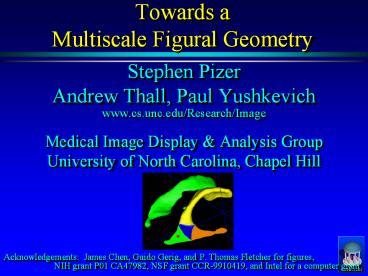Towards a Multiscale Figural Geometry - PowerPoint PPT Presentation
Title:
Towards a Multiscale Figural Geometry
Description:
Stephen Pizer Andrew Thall, Paul Yushkevich www.cs.unc.edu/Research/Image Medical Image Display & Analysis Group University of North Carolina, Chapel Hill – PowerPoint PPT presentation
Number of Views:101
Avg rating:3.0/5.0
Title: Towards a Multiscale Figural Geometry
1
Towards aMultiscale Figural Geometry
- Stephen Pizer
- Andrew Thall, Paul Yushkevich
- www.cs.unc.edu/Research/Image
- Medical Image Display Analysis Group
- University of North Carolina, Chapel Hill
- Acknowledgements James Chen, Guido Gerig, and
P. Thomas Fletcher for figures, NIH grant
P01 CA47982, NSF grant CCR-9910419, and Intel for
a computer grant
2
Intrinsic Object-Based Geometry Suitable for
Shape Description
- The need object-based positional, orientational,
and metric correspondence among topologically
figurally equivalent objects or groups of objects - Boundary of object
- In interior of object
- Exterior to object, between objects
- Suitability for shape description implies
- Magnification invariance
- At all levels of spatial scale (locality)
3
Definition of Spatial Scale
- Mesh of voxels Boundary atom mesh Medial
atom mesh
- Scale There are two separate and different
notions - Spatial coverage of each geometric element
- Distance of inter-element communication
4
Multiple Spatial Scales
- Mesh of voxels Medial atom mesh
- Scale aspects
- Geometric element coverage
- Inter-element communication distance
- Thesis The two measures need to be similar
- Multiple scale levels
5
Figural Geometry (position, orientation, local
size) Comes from Medial Atoms
- Medial atoms (1st order medial locus)
- x, F (b,n,b?) frame, r, q (object angle)
- b in direction of minimum dr/ds (-?xr)
- b? in level direction of r 3D
- n is normal to medial skeleton
6
Figurally RelevantSpatial Scale Levels
- Multiple objects
- Individual object
- i.e., multiple figures
- Individual figure
- mesh of medial atoms
- Figural section
- i.e., multiple figural sections
- figural section centered at medial atom
- Figural section more finely spaced, ..
- Boundary section
- Boundary section more finely spaced, ...
7
Figural Types and the Manifold of Medial Atoms
M-rep Boundary implied from interpolated
continuous manifold of medial atoms
Slab Tube
8
Magnification Invariance at All Spatial Scale
Levels
- Inside boundary features
- radius of curvature-proportional distances
- Inside figural sections
- r-proportional distances
- Inside individual figures
- r-proportional distances
9
Magnification Invariance at All Spatial Scale
Levels
- Individual object
- In interface between figures
- blended r-proportional distances
- Multiple objects
- Outside objects
- blended r-proportional distances
- concavities effect disappear with distance
10
Figural (Medially based) Geometry
- Locally magnification invariant means
r-proportional distances - Along medial skeleton
- Along medial sails (implied boundary normals)
- Medially (figurally) based coordinate system
provides intrinsic coordinates - Along medial skeleton
- Along medial sails (implied boundary normals)
- Overall metric??
11
Spatial coordinates capable of providing
correspondence at any scale
- Medial coordinates (u,v)
- continuous, integer multiples of lr at samples,
where l is scale level - r-proportional along medial surface
- Boundary coordinates (u,v,t)
- Spatial coordinates (u,v,t,d/r)
- From implied boundary along geodesic of distance
that at boundary is in normal direction
12
Figural Coordinates for Single Figure
- Inside object (u,v,t,d/r)
- (u,v) give multiples of r
- distance on medial sheet along geodesics of
r-proportional distance - Outside object
- Near boundary (inside focal surface)
(u,v,t,d/r) - Far outside boundary (u,v,t,d/r) via distance
(scale) related figural convexification - geodesics do not cross
13
Figural Coordinates for Object Made From
Multiple Attached Figures
- Inside figures not near hinges
- same as for single figure
- Outside object see two slides later
14
Figural Coordinates for Object Made From
Multiple Attached Figures
- Blend in hinge regions
- w(d1/r1 - d2 /r2 )/T
- Blended d/r when w lt1 and u-u0 lt T
- Implicit boundary (u,w, t)
- Implicit normals and geodesics
15
Figural Coordinates between Objects
- Near boundary via blending
- Far outside boundary
- same convexification principle as with single
figures - blend geodesics according to dk/rk
16
Uses of Correspondence
- Geometric typicality (segmentn prior)
- by boundary point to boundary point
correspondence - Geometric representation to image match measure
- by boundary-relative correspondence
- in collar about boundary out to fixed distance
via metric - union of collar and interior of object
- For homologies used in statistical shape
characterization leads to locality - For elements in mechanical calculations
- For comparison of segmented object to true
object
17
Open Geometric Questions
- Full space metric
- Outside figure convexification
- Reflecting scale level
- Representing tolerance
- Controlling IImedial locus, Dx2r, ?xr
- Principled means for
- Inter-figural blending of figural metrics for
attached figures - Inter-object blending of object metrics
18
Figural (Medially based) GeometryInternal points
on single figure
- Sails are separate (qgt0)
- Both sails move with motion on medial surface
19
Figural (Medially based) GeometryBranches and
Ends
- Ends
- Sails come together (q0)
- Boundary is vertex (2D) or crest (3D)
- Medial disk or ball osculates
- Branches
- Medial disk or ball tritangent
- Swallowtail of medial atom
- Retrograde motion of one sail
20
Multiscale Geometry and Probability for a Figure
coarse, global
- Geometrically ? smaller scale
- Interpolate (1st order) finer spacing of atoms
- Residual atom change, i.e., local
- Probability
- At any scale, relates figurally homologous points
- Markov random field relating medial atom with
- its immediate neighbors at that scale
- its parent atom at the next larger scale and the
corresponding position - its children atoms
coarse resampled
fine, local































